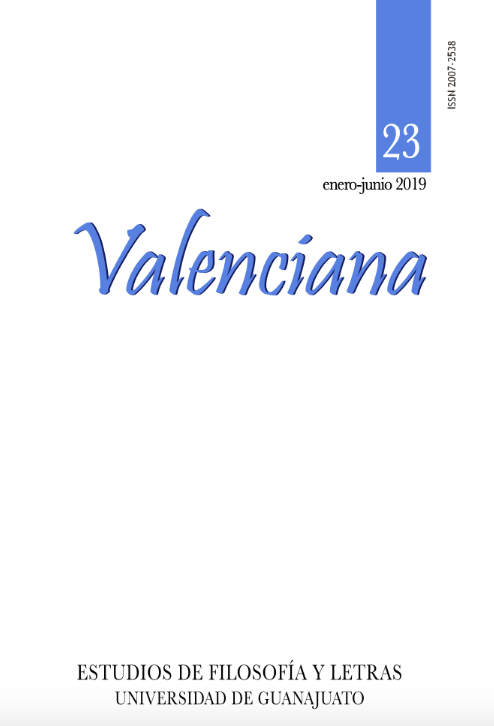Towards a phenomenology of hyperrealistic dolls
DOI:
https://doi.org/10.15174/rv.v0i23.424Abstract
Hyperrealistic artefacts are increasingly and rapidly spreading: “real dolls” are used as life- or sex partners; “reborn dolls” uncannily replicate the physical features of real infants; in the short term, androids are likely to play a crucial role in virtually all domains of society; and the rapid pace of technological development already suggests that there will be an exponential growth in the application of artificial intelligence to human replicas. By adopting a phenomenological perspective, this essay means to provide a theoretical explanation of hyperrealism and its walking the line between “perception” and “image consciousness” on the one hand, and between “deception” and “aesthetic illusion” on the other.
References
Arnheim, Rudolf, 1959, “The Robin and the Saint: On the Twofold Nature of the Artistic Image”, The Journal of Aesthetics and Art Criticism, vol. 18, núm. 1, pp. 68-79.
Bach, Ferdinand-Sigismond, 1929, Le voyage à Berlin. La fin de l’Allemagne romantique, Conard, Paris.
Baudrillard, Jean, 1995, El crimen perfecto, traducción de Joaquín Jordá, Anagrama, Barcelona, 1996.
Benjamin, Walter, 1927-1940, Libro de los Pasajes, edición de Rolf Tiedemann, traducción de Luis Fernández Castañeda, Isidro Herrera y Fernando Guerrero, Akal, Madrid 2004.
Blumenberg, Hans, 1989, Höhlenausgänge, Suhrkamp, Frankfurt am Main.
Breton, André, 1928, Nadja, Traducción de José Ignacio Velazquez, Cátedra, Madrid 2004.
Conte, Pietro, 2014, In carne e cera. Estetica e fenomenologia dell’iperrealismo, Quodlibet, Macerata.
Pinotti, Andrea, 2017, “Self-Negating Images: Towards An-Iconology”, Proceedings, vol. 1, pp. 1-9 (doi:10.3390/proceedings1090856).
Därmann, Iris, 1995, Tod und Bild. Eine phänomenologische Mediengeschichte, Fink, Munich.
Gombrich, Ernst, 1951, “Meditaciones sobre un caballo de juguete o Las raices de la forma artistica”, en Meditaciones sobre un caballo de juguete y otros ensayos sobre la teoría del arte, traducción de José María Valverde, Debate, Madrid 1996, pp. 3-11.
Husserl, Edmund, 1900-1901, Investigaciones Lógicas, traducción de Manuel García Morente y José Gaos, 2 Volúmenes, Alianza, Buenos Aires 2005.
——, 1904-1905, “Phantasy and Image Consciousness”, en Husserl, 2005, pp. 1-115.
——, 1912a, “On the Analysis of Memory. Characterization of Internal Memory and Characterization through the Later Nexus. Omission and Supervention of Position Takings” (1912), en Husserl, 2005, pp. 497-507.
——, 1912b, “Reproduction and Image Consciousness”, Appendix L: “On Imagination“ (1912), en Husserl, 2005, pp. 569-573.
——, 1948, Experiencia y Juicio. Investigaciones acerca de la genealogía de la lógica, traducción de Jas Reuter y revisión de Bernabé Navarro, edición de Ludwig Landgrebe, con un epilogo de Lothar Eley, Instituto de Investigaciones Filosoficas, UNAM, México, 1980.
——, 2005, Phantasy, Image Consciousness, and Memory (1898-1925), trans. by John B. Brough, Springer, Dordrecht.
Lange, Konrad, 1901, Das Wesen der Kunst: Grundzüge einer realistischen Kunstlehre, 2 vols, Grote’sche Verlagsbuchhandlung, Berlin.
O’Doherty, Brian, 1999, Dentro del cubo blanco. La ideología del espacio expositivo, traducción de Lena Peñate Spicer revisada por Fernando Villaverde y Marta Morales, Centro de Documentación y Estudios Avanzados de Arte Contemporáneo, Murcia 2011.
Ortega y Gasset, José, 1921, “Meditación del marco”, en Obras completas de José Ortega y Gasset, tomo 2, Revista de Occidente, Madrid 1963, pp. 307-313.
Seemann, Hans Jürgen, 2000, Bild als Widerstreit. Zur Phänomenologie des Bildes im Anschluß an die Untersuchungen E. Husserls. Ein Beitrag zur Phänomenologie der anschaulichen Unmöglichkeit, Dissertation, Wuppertal.
Steinmetz, Rudy, 2011, L’esthétique phénoménologique de Husserl. Une approche contrastée, Kimé, Paris.
Published
How to Cite
Issue
Section
License
Author(s) who publish in this journal do accept the next conditions:
According to copyright regulations, Valenciana does recognize and respect the authors’ moral right, as well as the right of property, which will be assigned to the journal for its diffusion in open access.
Valenciana does not charge authors for the submission, editorial process or publication in the journal.
All texts published and distributed by Valenciana (without exception) are supported by the license Creative Commons Attribution-NonCommercial 4.0 International (CC BY-NC 4.0), which allows third parties to use the publication as long as they mention the author and the first publication.
Authors can make other independent and additional contractual agreements for the non-exclusive use of his article published in Valenciana (e.g. including it in an institutional repository or in printed/electronic media), as long as it is explicitly clarified that the article was published for the first time in this journal.
For these purposes, authors must sign and send the letter of submission and copyright transfer form in a PDF file to this email address: revistavalenciana@gmail.com
This journal is under a license by Creative Commons Atribución-NoComercial-SinDerivadas 4.0 Internacional (CC BY-NC-ND 4.0)).











